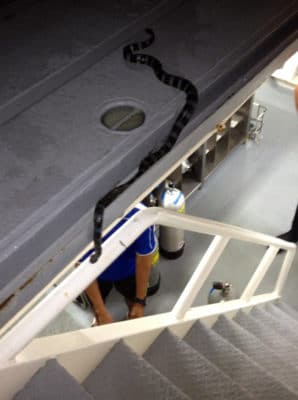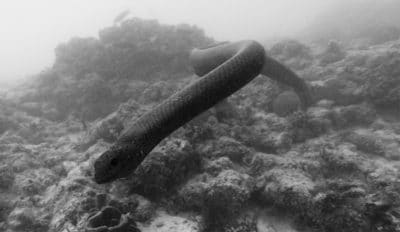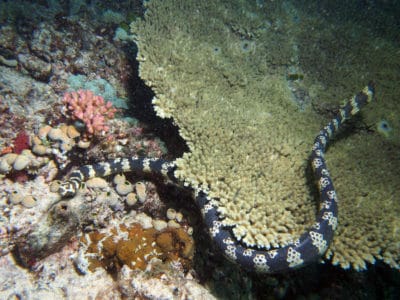Yesterday, while exploring a nearby island, Dive Safety Officer, Nick Cautin, spotted 15 sea snakes on the beach! We seem to be seeing them everywhere – on land, SCUBA diving, and even on the aft deck of the M/Y Golden Shadow (our research vessel). You may recall from our previous blog that sea snakes are air breathing reptiles that inhabit both the land and sea. Read more about sea snakes in our past blog https://livingoceansfoundation.org/snakes-2/.

Species of Sea Snakes in New Caledonia
Why do there seem to be so many? It seems that this area of New Caledonia may be a hotspot for these snakes. There are thought to be twelve species of sea snakes that occur in New Caledonia. So far, we have seen four different species including the blue-banded sea snake, Lauticada lauticadata; the banded sea krait, Laticauda colubrina; the golden sea snake, Aipysurus laevis; and the turtle-headed sea snake, Emydocephalus annulatus.

Scientific Diver, Ken Marks, was the first to spot the turtle-headed snake while it was sheltering in a small crevice in the reef. As the dive continued, five more were seen swimming around the reef. Though common in New Caledonia, this is the first time the turtle-headed sea snake has been seen on the Global Reef Expedition.

Turtle-headed sea snakes are commonly found throughout the Indo-Pacific; however, studies show that these snakes continuously return to the same area. They may continue to return to this area due to the many beaches and nesting places that make up their habitat. Additionally, there are lots of lagoonal areas with lots of food. Studies have also shown that this species of sea snakes feeds primarily on fish eggs, unlike the banded sea krait that feeds on small fish and eels.

With a little more luck, we will continue see these remarkable and mysterious creatures on our scientific dives as we carry on with our mission in New Caledonia.
Photos by: 2 Serge Andrefouet; 3-4 Andrew Bruckner